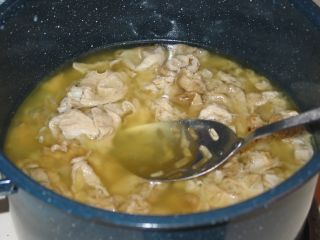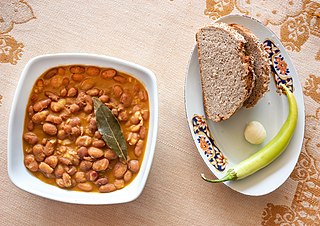Related Research Articles

Chitterlings, sometimes spelled chitlins or chittlins, are the small intestines of domestic animals. They are usually made from pigs' intestines. They may also be filled with a forcemeat to make sausage. Intestine from other animals, such as beef, lamb, and goat is also used for making chitterling.

Feijoada is a stew of beans with beef and pork. The name feijoada comes from feijão, 'bean' in Portuguese. It is widely prepared in the Portuguese-speaking world, with slight variations.

Sancocho is a traditional soup in several Latin American cuisines. Variations represent popular national dishes in Dominican Republic, Colombia, Cuba, Honduras, Ecuador, Panama, Puerto Rico, Trinidad and Tobago, and Venezuela. It usually consists of large pieces of meat, tubers and vegetables served in a broth.

Sofrito, sofregit (Catalan), soffritto, or refogado is a basic preparation in Mediterranean, Latin American, Spanish, Italian and Portuguese cooking. It typically consists of aromatic ingredients cut into small pieces and sautéed or braised in cooking oil.

Pasta e fagioli, meaning "pasta and beans", is a traditional Italian pasta soup. It is often called pasta fasul or pasta fazool in the New York Italian dialect, derived from its Neapolitan name, pasta e fasule.

Caparrones is a Spanish stew made of caparrón, a variety of red kidney bean, and a spicy sausage chorizo, both of which are local specialties of the Spanish La Rioja region. The shape of caparrón bean is shorter and rounder than common red kidney beans. The stew is regarded as one of the most important dishes in Riojan cooking.

Dominican cuisine is made up of Spanish, indigenous Taíno, Middle Eastern and African influences.
Sagamité is a Native American stew made from hominy or Indian corn and grease. Additional ingredients may include vegetables, wild rice, brown sugar, beans, smoked fish or animal brains.

Khoresh or Khoresht is a generic Iranian term for stew dishes in the Iranian cuisine, Afghan cuisine, Tajik cuisine and also Kurdish cuisine. The word is a substantive of the verb khordan "to eat" and literally means "meal".

Pasulj, grah (грах) or grav (грав) is a bean stew made of usually white, cranberry or pinto beans, and more rarely kidney beans that is a popular dish in Balkan cuisine. It is normally prepared with meat, particularly smoked meat such as smoked bacon, sausage, and ham hock, and is a typical winter dish. Other commonly used ingredients include carrots and onions. Another version of the dish using baked beans is known as prebranac (пребранац).

Cocido montañés is a rich hearty Spanish bean stew, originally from and most commonly found in Cantabria in northern Spain.

Kapuska is a hearty traditional Turkish cuisine and Balkan cuisine stew whose name is derived from the Slavic languages word for cabbage. Although the name is imported, the dish is a Turkish version of a cabbage stew common in Russia, Ukraine, Poland and other countries of Eastern Europe. Kapuska is widely known and consumed in the Thrace and Black Sea regions of Turkey.

Kuru fasulye is a stewed bean dish in Turkish cuisine. It is made primarily with white beans and olive oil, and onion and tomato paste or tomato sauce are almost invariably used. Sometimes other vegetables or meat may also be added, especially pastirma. Kuru fasulye is often served along with rice or bulgur. It is often considered the national dish of Turkey.

A stew is a combination of solid food ingredients that have been cooked in liquid and served in the resultant gravy. A stew is not a soup. A stew needs to have raw ingredients added to the gravy. Ingredients in a stew can include any combination of vegetables and may include meat, especially tougher meats suitable for slow-cooking, such as beef, pork, lamb, poultry, sausages, and seafood. While water can be used as the stew-cooking liquid, stock is also common. A small amount of red wine is sometimes added for flavour. Seasoning and flavourings may also be added. Stews are typically cooked at a relatively low temperature, allowing flavours to mingle.
Stew peas is a Jamaican stew prepared using coconut milk, beans and salted meat. It is a common dish in Jamaica.
Capra e fagioli or Stufato di capra e fagioli is a typical dish of the hinterland of Imperia.
Linat-an, also known as nilat-an, is a traditional pork stew from the Visayas and Mindanao islands of the Philippines. Linat-an characteristically uses pork ribs boiled and simmered until very tender, lemongrass, string beans, and starchy ingredients for a thicker soup. Like the very similar nilagang baboy, the rest of its ingredients can vary, but they typically include chayote, water spinach, onion, garlic, pechay, calabaza, and bell peppers. It is seasoned with salt, ground black pepper, and fish sauce to taste.
References
- ↑ "Recipe: Vegan Dominican Chapea Stew". MLive.com. November 6, 2013. Retrieved December 22, 2017.